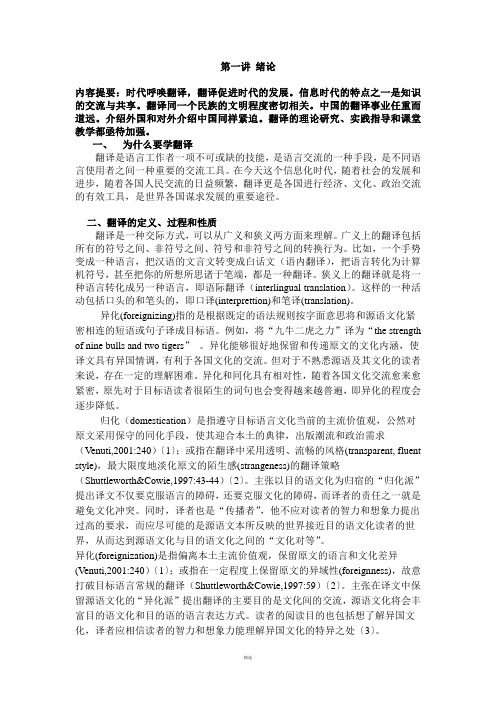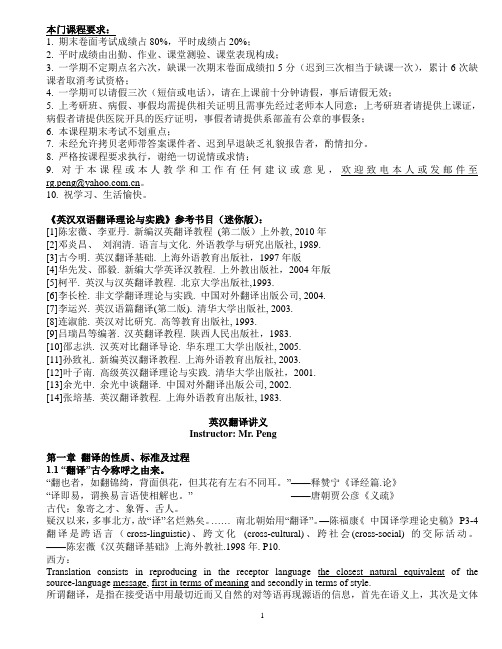英汉翻译讲义
英汉翻译第一讲讲义

第一讲绪论内容提要:时代呼唤翻译,翻译促进时代的发展。
信息时代的特点之一是知识的交流与共享。
翻译同一个民族的文明程度密切相关。
中国的翻译事业任重而道远。
介绍外国和对外介绍中国同样紧迫。
翻译的理论研究、实践指导和课堂教学都亟待加强。
一、为什么要学翻译翻译是语言工作者一项不可或缺的技能,是语言交流的一种手段,是不同语言使用者之间一种重要的交流工具。
在今天这个信息化时代,随着社会的发展和进步,随着各国人民交流的日益频繁,翻译更是各国进行经济、文化、政治交流的有效工具,是世界各国谋求发展的重要途径。
二、翻译的定义、过程和性质翻译是一种交际方式,可以从广义和狭义两方面来理解。
广义上的翻译包括所有的符号之间、非符号之间、符号和非符号之间的转换行为。
比如,一个手势变成一种语言,把汉语的文言文转变成白话文(语内翻译),把语言转化为计算机符号,甚至把你的所想所思诸于笔端,都是一种翻译。
狭义上的翻译就是将一种语言转化成另一种语言,即语际翻译(interlingual translation)。
这样的一种活动包括口头的和笔头的,即口译(interprettion)和笔译(translation)。
异化(foreignizing)指的是根据既定的语法规则按字面意思将和源语文化紧密相连的短语或句子译成目标语。
例如,将“九牛二虎之力”译为“the strength of nine bulls and two tigers”。
异化能够很好地保留和传递原文的文化内涵,使译文具有异国情调,有利于各国文化的交流。
但对于不熟悉源语及其文化的读者来说,存在一定的理解困难。
异化和同化具有相对性,随着各国文化交流愈来愈紧密,原先对于目标语读者很陌生的词句也会变得越来越普遍,即异化的程度会逐步降低。
归化(domestication)是指遵守目标语言文化当前的主流价值观,公然对原文采用保守的同化手段,使其迎合本土的典律,出版潮流和政治需求(Venuti,2001:240)〔1〕;或指在翻译中采用透明、流畅的风格(transparent, fluent style),最大限度地淡化原文的陌生感(strangeness)的翻译策略(Shuttleworth&Cowie,1997:43-44)〔2〕。
英语翻译课堂讲义

导学——课程要求
Requirements and Grading:
To pass this course, students must attain an average of 60% in the following categories: Participating: 10%
Participating is vital to the learning process and it includes attendances, being on times, coming to class prepared, interacting with other students, and participating in classroom discussions. Students who are frequently absent, tardy, or refuse to participate will receive a poor participation grade. Note: there are NO excused absences. Any absences or tardy will result in a lower participation grade.
3.《英汉翻译概要》,靳梅林 编著, 南开大学出版 社,1998年。
4.《新编汉英翻译教程》,陈宏薇 编著,上海外语教 育出版社,2004年。
5.《英汉翻译教程》,连淑能 编著,高等教育出版社, 2006年。
19
导学——学习网站
1. 中国翻译协会 /tran/index.htm 2. 中国科技翻译
Thursday
Classroom
IA3
14:00—16:00 p.m.
04.英汉语言对比与翻译_讲义

04.英汉语⾔对⽐与翻译_讲义第四章英汉语⾔对⽐与翻译Fiona Ma April, 201221. 英汉语⾔特点2. 英汉语⾔特点对翻译的启⽰3. 课堂互动及课后练习英汉语⾔对⽐与翻译1.英语重形合,汉语重意合2.英语偏静态,汉语偏动态3.英语重抽象,汉语重具体4.英语重物称,汉语重⼈称5.英语重被动,汉语重主动6.英语多替换,汉语多重复7.英语重后饰,汉语重前饰8.英语重聚焦,汉语重流散9.英语重时体,汉语轻时体1. 英汉语⾔特点返回章重点 4例1: Children will play with dolls equipped withpersonality chips, computers with in-built personalities will be regarded as workmates rather than tools, relaxation will be in front of smell television, and digital age will have arrived.【译⽂】⼉童将与装有个性芯⽚的玩具娃娃玩耍,具有个性内置的计算机将被视为⼯作伙伴⼉不是⼯具,⼈们将在⽓味电视前休闲,这时数字时代就来到了。
例2: 早知今⽇,何必当初?【译⽂】If I had known it would have come to this, I would have acted differently.1.1 英语重形合,汉语重意合1. 英汉语⾔特点返回章重点 5例3: As we lived near the road, we oftenhad the traveler or stranger visit us to taste our gooseberry wine, for which we had great reputation, and I confess, with the veracity of an historian that I never knew one of them to find fault with it.【译⽂】我们就住在路边。
英汉互译讲义

Unit 1Introduction: Translation and Translation TechniquesLearning Objectivesto know the important role of translationto know the nature and scope of translationto know the development of translation theoriesto know the principles of translationto grasp two concepts: literal translation & free translationto know some basic translation techniquesI. Importance/Definition/Scope of TranslationImportant Role of TranslationThe Nature of TranslationWhat is Translation?a science/ an art/ a craft/ a skill ?fanyi--subject/ profession/ works/ activities/ translator中国,蛮,夷,戎,狄……五方之民,言语不通,嗜欲不同。
达其志,通其欲,东方曰寄,南方曰象,西方曰狄,北方曰译。
--《礼记·王制》“今通西言而云译者,盖汉世多事北方,而译官兼善西语,故摩腾始至,译《四十二章》,因称译也”。
--《翻译名义集》卷一译即易,谓换易言语使相解也。
--《义疏》翻译就是把已说出的或写出的话的意思用另一种语言表达出来的活动。
《中国大百科全书·语言文字》Translation means “to give the meaning of something said or written in another language. ” (Oxford Learner’s Dictionary of Current English with Chinese Translation)Translating consists in reproducing the closest natural equivalent of the source language message into the target language, firstly in terms of meaning, and secondly in terms of style. --Eugene A. Nida翻译不仅涉及语言问题,也涉及文化问题。
《汉英翻译讲义》课件

欢迎来到《汉英翻译讲义》PPT课件,让我们一起探索翻译的技巧和难点,以 及在不同领域的实战经验。
翻译原则
语言交流原则
将信息以准确、流畅的方式传达给目标受众。
信、达、雅、俗原则
在平衡忠实于原文、易于理解、符合礼仪和符合 语言习惯之间做出取舍。
文化渊源原则
考虑源语和目标语所处的文化背景以确保准确的 意义传递。
2 翻译学习的必要性
为了提高翻译能力和专业素养,学习翻译技巧是必要的。
3 翻译的的未来趋势
探讨翻译行业在数字化时代的发展和应对策略。
全译原则
尽可能将所有内容都翻译出来,不遗漏任何重要 信息。
常用翻译技巧
1 转换语序
调整句子中单词的顺序以符合目标语言的语 法规则。
2 转换词性
将源语言中的名词、动词等转换成目标语言 中相应的词性。
3 表达省略
在目标语言中省略源语言中过于冗长或不必 要的表达。
4 表达冗余
在目标语言中增添必要的信息以充实表达内 容。
Hale Waihona Puke 5 摆脱中式英语避免使用中式英语,使用符合目标语言规范 的表达方式。
6 合理使用专业词汇
根据目标受众和领域需求,使用准确的专业 词汇。
翻译难点
1 词汇难度
处理复杂或文化相关的词汇时可能出现困难。
2 文化差异
文化差异可能导致翻译过程中的困惑或误解。
3 常见错误
容易犯的一些翻译错误和应对策略。
翻译实战
1
文化背景下的翻译
在涉及文化背景的文本中应用翻译技巧
媒体报道翻译
2
和文化敏感度。
准确翻译媒体报道的信息以便更好地传
播。
英汉翻译讲义[2].彭
![英汉翻译讲义[2].彭](https://img.taocdn.com/s3/m/5ab5ac16650e52ea551898f8.png)
*I had not known him for 20 years without learning that he always kept in
the upper-left pocket of his waistcoat the little book in which he put down his engagement. *It was decided that they should remain under British military rule for the time being,and that if the four powers could not agree within a year as to their disposition,the matter would be referred to the United Nations General Assembly. *The Conservative party was hard hit when War Minister John was involved in a moral scandal that furnished the British press with headlines for weeks.
6 英汉语言对比与翻译
(1)谱系 (英:印欧语系 汉:汉藏语系) (2)类型 (英:分析综合型 汉:分析粘着型) (3)文字系统 (英:拼音文字 汉:表意表形文字) (4)语音 (英:语调语言 汉:声调语言) (5)词汇(英:词义较具体准确,有冠词。 汉:词义较笼统模糊, 有量词,双音节词,四字词组使用率高)
*It is essential that every child should have the same opportunity to have education.(语序对比4)
英汉翻译讲义 - 新课本

Chapter OneI.Brief Introduction to the course1.Aims:The course is aimed at providing opportunities for non-English majors in Honghe University to learn the basic principles and techniques of E-C and C-E translation. The principles will include knowledge about the nature of translation, the functions and theirs of language, linguistic and communication theories in translation and the competence of a translator. In learning the techniques of translation, the students will mainly work on the analysis of a text, word meanings in context, the process of translation, feasibility of literal translation and expression in idiomatic Chinese and English.The course will also help the students to gain insight into translation from cultural and aesthetic perspectives to enhance their competence in the two languages. By the end of the course, the students are expected to be able to translate, with reasonable accuracy, faithfulness and appropriateness, passages on common subjects in everyday communication.2.Teaching Procedures:The class will mainly be conducted in lecturing and commenting on students‟exercise and class performance. Discussion, questions and answers will be encouraged throughout the whole course. Homework assignments will play an important part in the course.3.Assessment:Assessment will be through class-work, homework, class performance and formal testing. TheAttendance is both monitored and graded. Students will absence exceeding three times will be reported to the department and grades will not be submitted to these students.II.On Translation1.What is Translation?翻译是用一种语言形式把另一种语言形式里的内容重新表现出来的语言实践活动。
英汉翻译讲义

本门课程要求:1. 期末卷面考试成绩占80%,平时成绩占20%;2. 平时成绩由出勤、作业、课堂测验、课堂表现构成;3. 一学期不定期点名六次,缺课一次期末卷面成绩扣5分(迟到三次相当于缺课一次),累计6次缺课者取消考试资格;4. 一学期可以请假三次(短信或电话),请在上课前十分钟请假,事后请假无效;5. 上考研班、病假、事假均需提供相关证明且需事先经过老师本人同意;上考研班者请提供上课证,病假者请提供医院开具的医疗证明,事假者请提供系部盖有公章的事假条;6. 本课程期末考试不划重点;7. 未经允许拷贝老师带答案课件者、迟到早退缺乏礼貌报告者,酌情扣分。
8. 严格按课程要求执行,谢绝一切说情或求情;9. 对于本课程或本人教学和工作有任何建议或意见,欢迎致电本人或发邮件至rg.peng@。
10. 祝学习、生活愉快。
《英汉双语翻译理论与实践》参考书目(迷你版):[1]陈宏薇、李亚丹. 新编汉英翻译教程(第二版)上外教, 2010年[2]邓炎昌、刘润清. 语言与文化. 外语教学与研究出版社, 1989.[3]古今明. 英汉翻译基础. 上海外语教育出版社,1997年版[4]华先发、邵毅. 新编大学英译汉教程. 上外教出版社,2004年版[5]柯平. 英汉与汉英翻译教程. 北京大学出版社,1993.[6]李长栓. 非文学翻译理论与实践. 中国对外翻译出版公司, 2004.[7]李运兴. 英汉语篇翻译(第二版). 清华大学出版社, 2003.[8]连淑能. 英汉对比研究. 高等教育出版社, 1993.[9]吕瑞昌等编著. 汉英翻译教程. 陕西人民出版社,1983.[10]邵志洪. 汉英对比翻译导论. 华东理工大学出版社, 2005.[11]孙致礼. 新编英汉翻译教程. 上海外语教育出版社, 2003.[12]叶子南. 高级英汉翻译理论与实践. 清华大学出版社,2001.[13]余光中. 余光中谈翻译. 中国对外翻译出版公司, 2002.[14]张培基. 英汉翻译教程. 上海外语教育出版社, 1983.英汉翻译讲义Instructor: Mr. Peng第一章翻译的性质、标准及过程1.1 “翻译”古今称呼之由来。
- 1、下载文档前请自行甄别文档内容的完整性,平台不提供额外的编辑、内容补充、找答案等附加服务。
- 2、"仅部分预览"的文档,不可在线预览部分如存在完整性等问题,可反馈申请退款(可完整预览的文档不适用该条件!)。
- 3、如文档侵犯您的权益,请联系客服反馈,我们会尽快为您处理(人工客服工作时间:9:00-18:30)。
E-C Translation Course NotesDefinitionTranslation consists in reproducing in the receptor language the closest natural equivalent of the source-language message, first in terms of meaning and secondly in terms of style.(Eugene A. Nida)Significance of TranslationPlays the key role in inter-cultural communication1. Bringing about mutual understanding and friendliness among nations.2. Enriching our own experiences and knowledge of the world.The most important media in international trade and business. ------No translation, no globalization.The Criteria of TranslationTytler (p.5)严复:faithfulness, intelligibility, and elegance(信达雅)林语堂:忠实,通顺,美钱钟书:化境傅雷:神似The procedures of translationAccurate comprehensionAdequate representationCareful proofreadingRequirements on the translatorsGood command of the languagesWide scope of knowledgeSensitive to cultural differencesHard working and willing to sacrifice personal gains and interestsStrong sense of responsibilityLiteral Vs. free translationsThe former focuses on a word-for-word translation of the source text into the target text; while the latter involves language adjustment in the process of translation.No matter what method you may use, your translation should be correct, comprehensible to the target reader and close to the original style. Only when you keep the meaning and spirit of the original sentence structure a nd/or its figure of speech can your translation be regarded as proper literal translation, otherwise it is merely mechanical translation.Similarly, only when change the original sentence structure and/or the figure of speech but make no addition or deletion of the original meaning and spirit, can your translation be regarded as proper translation; otherwise it is simply random translation.The designative meaning of a word (指称义) refers to the object, people, plant, animal, place, etc. that it represents; while the associative meaning of a word (内涵义) is the idea, quality, state, circumstance, etc. that it makes you think of.Formal vs. Functional EquivalenceFormal equivalence (形式对等) focuses on the match between the source text and the target text as close as possible in both form and content; while functional equivalence (功能对等)stresses the closest parallel of the target text to the source text in communicative function.If the communicative function of the source text can be translated into the target text without having to change the form of the former, formal equivalence should be strived for;whereas if the strict reservation of the structure of the source text constitutes an obstacle to the transmission of the communicative function, adjustment then needs to be made structurally for the establishment of functional equivalence.Hypotaxis(形合) vs. parataxis (意合)English is a language of hypotaxis(形合). It heavily depends on grammar for constructing different linguistic parts into a sentence or an article. the Grammatical meanings in the language of English are reflected in such aspects as the suffix (后缀) of a word (e.g.“-s, -ing or -ed”), the tenses(时态), the voices(语态), the moods(语气), constructions(结构), and such functional words like articles, conjunctions, pronouns or prepositions. On the contrary, Chinese, being a language of parataxis (意合),has the parts linked up with each other semantically or through the context. Therefore, when English is being translated into Chinese, some of the words mentioned above need to be omitted out of grammatical or rhetorical considerations.Syntactic marking (语法标义)vs. semotactic marking(语义标义)Syntactic marking refers to those situations when the meaning of a word in a sentence is specified by the grammatical construction of the sentence.Semotactic marking refers to the determination of the meaning of an English word by some other words in the sentence, which form the semotactic environment for that word. In other words, the context, built up by the words prior to or following the word, can often provide clues as to what the word means.Syntactic marking interplays with semotactic marking in the specification of the meaning of an English word.Form and ContentIf we assume that language is a device for communicating messages, then it follows that language and linguistic forms are means to an end rather than an end in themselves. The content is the conceptual intent of the message, together with the connotative values the source text wishes to communicate; it is what the message is about.The form, on the other hand, is the external shape the message takes to effect its passage from the source’s mind to the receptor’s mind.In transferring the message from one language to another, it is the content which must be preserved at any cost; the form, except in special cases, such as poetry, is largely secondary,variable.It is a bit like packing clothing into two different pieces of luggage: the clothes remain the same, but the shapes of the suitcases may vary greatly, and hence the ways in which the clothes are packed must be different.We preserve the form when we can, but more often the form has to be transformed precisely in order to preserve the content. An excessive effort to preserve the form inevitab ly results in a serious loss or distortion of the message.Semantic adjustment made in transfer—Specific meaning Vs. generic meaning Some of the most common shifts in meaning found in the transfer process are modifications which involve specific (个别意义)and generic (一般意义)meanings. Such shifts may go in either direction, from generic to specific , or from specific to generic.Semantic adjustment —Analytic process Vs. synthetic process分析过程综合过程In the transfer process, sometimes the semantic contents of a word or a group of words need to be redistributed through either an analytical or synthetic process. The former involves expanding the semantic content of a word over a number of words; and the latter group s the semantic contents of several words into one or two words.Structural adjustmentThere are numerous features of the sentence structure, which must be adjusted in the process of transfer from one language to another. Such features, among others, concern word and phrase order, gender, class and number concord, active and passive constructions and ellipsis,etc.Discourse adjustmentAn English discourse generally starts with a topic sentence followed by the explanatory statements or supportive examples and ends up with a conclusion. The sentences in the discourse are often logically connected with each other by such cohesive markers(连接手段)as “first of all”, “furthermore”, “in addition”, “however”, “therefore”, “to sum up”, etc. The sentences in a Chinese discourse, though not always bound up together through formally distinct devices, actually all center on the theme of the text.Translation skillsChanging the positions of some phrasesChanging words or phrases into sentencesChanging the part of speechMain clause firstChanging the positions of the major componentsAdding words when necessaryKey word repetitionBreaking a long sentence into several short sentencesLeaving out unnecessary wordsUse of four-character phrasesPositive and negative ways of expressing an ideaDealing with idiomsThe former focuses on a -translation of the -text into the -text; while the latter involves language -in the process of translation.No matter what method you may use, your translation should be -, c-to the target reader and close to the original -. Only when you keep the-and-of the original sentence-a nd/or its-can your translation be regarded as proper literal translation, otherwise it is merely m-translation.Similarly, only when change the original sentence structure and/or the figure of speech but make no addition or deletion of the original meaning and spirit, can your translation be regarded as proper translation; otherwise it is simply r-translation. Designative Vs. associative meaningsThe designative meaning of a word (指称义) refers to the object, people, plant, animal, place, etc. that it-; while the associative meaning of a word (内涵义) is the idea, quality, state, circumstance, etc. that it makes you-.Formal vs. Functional EquivalenceFormal equivalence (形式对等) focuses on the -between the source text and the target text as close as possible in both -and -; while functional equivalence (功能对等)stresses the c- p- of the target text to the source text in -function.If the communicative function of the source text can be translated into the target text without having to change the form of the former, -should be strived for; whereas if the strict reservation of the structure of the source text constitutes an obstacle to the transmission of the communicative function, adjustment then needs to be made s-for the establishment of functional equivalence.Hypotaxis(形合) vs. parataxis (意合)English is a language of —. It heavily depends on ——for constructing different linguistic parts into a sentence or an article. the Grammatical meanings in the language of English are reflected in such aspects as the s- (后缀) of a word (e.g.“-s, -ing or -ed”), the t-(时态), the v-(语态), the m-(语气), c-(结构), and such functional words like a-, c-, p- or p-. On the contrary, Chinese, being a language of---, has the parts linked up with each other s- or through the c-. Therefore, when English is being translated into Chinese, some of the words mentioned above need to be o-out of g- or r- considerations.Syntactic marking (语法标义)vs. semotactic marking(语义标义)Syntactic marking refers to those situations when the meaning of a word in a sentence is -ed by the-cal construction of the sentence.Semotactic marking refers to the determination of the meaning of an English word by some other words in the sentence, which form the - environment for that word. In other words, the-, built up by the words prior to or following the word, can often provide clues as to what the word means.Syntactic marking interplays with semotactic marking in the -of the meaning of an English word.Form and ContentIf we assume that language is a device for communicating messages, then it follows that - and -c forms are means to an end rather than an end in themselves. The content is the ---------of the message, together with the - values the source text wishes to communicate; it is what the message is about.The form, on the other hand, is the --------------the message takes to effect its passage from the source’s mind to the receptor’s mind.In transferring the message from one language to another, it is the content which must be preserved at any cost; the form, except in special cases, such as ------, is largely secondary, since within each language the rules for content to form are highly c-, a-, and v-.It is a bit like packing clothing into two different pieces of luggage: the clothes remain the same, but the shapes of the suitcases may vary greatly, and hence the ways in which the clothes are packed must be different.We preserve the form when we can, but more often the form has to be transformed precisely in order to preserve the content. An excessive effort to preserve the form inevitably results in a serious loss or distortion of the message.。
